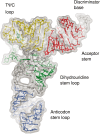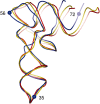The crystal structure of unmodified tRNAPhe from Escherichia coli
- PMID: 20203084
- PMCID: PMC2896525
- DOI: 10.1093/nar/gkq133
The crystal structure of unmodified tRNAPhe from Escherichia coli
Abstract
Post-transcriptional nucleoside modifications fine-tune the biophysical and biochemical properties of transfer RNA (tRNA) so that it is optimized for participation in cellular processes. Here we report the crystal structure of unmodified tRNA(Phe) from Escherichia coli at a resolution of 3 A. We show that in the absence of modifications the overall fold of the tRNA is essentially the same as that of mature tRNA. However, there are a number of significant structural differences, such as rearrangements in a triplet base pair and a widened angle between the acceptor and anticodon stems. Contrary to previous observations, the anticodon adopts the same conformation as seen in mature tRNA.
Figures







Similar articles
-
Solution conformations of unmodified and A(37)N(6)-dimethylallyl modified anticodon stem-loops of Escherichia coli tRNA(Phe).J Mol Biol. 2002 Jun 21;319(5):1015-34. doi: 10.1016/S0022-2836(02)00382-0. J Mol Biol. 2002. PMID: 12079344
-
Solution structure of psi32-modified anticodon stem-loop of Escherichia coli tRNAPhe.Nucleic Acids Res. 2005 Dec 23;33(22):6961-71. doi: 10.1093/nar/gki1004. Print 2005. Nucleic Acids Res. 2005. PMID: 16377777 Free PMC article.
-
Base pairing within the psi32,psi39-modified anticodon arm of Escherichia coli tRNA(Phe).J Am Chem Soc. 2006 Dec 13;128(49):15570-1. doi: 10.1021/ja0659368. J Am Chem Soc. 2006. PMID: 17147349
-
Metal ion stabilization of the U-turn of the A37 N6-dimethylallyl-modified anticodon stem-loop of Escherichia coli tRNAPhe.Biochemistry. 2004 Jan 13;43(1):55-66. doi: 10.1021/bi0353676. Biochemistry. 2004. PMID: 14705931
-
Ribosomal binding of modified tRNA anticodons related to thermal stability.Nucleic Acids Symp Ser. 1997;(36):58-60. Nucleic Acids Symp Ser. 1997. PMID: 9478206 Review.
Cited by
-
Adaptation of the Romanomermis culicivorax CCA-Adding Enzyme to Miniaturized Armless tRNA Substrates.Int J Mol Sci. 2020 Nov 28;21(23):9047. doi: 10.3390/ijms21239047. Int J Mol Sci. 2020. PMID: 33260740 Free PMC article.
-
Understanding the errors of SHAPE-directed RNA structure modeling.Biochemistry. 2011 Sep 20;50(37):8049-56. doi: 10.1021/bi200524n. Epub 2011 Aug 25. Biochemistry. 2011. PMID: 21842868 Free PMC article.
-
A two-dimensional mutate-and-map strategy for non-coding RNA structure.Nat Chem. 2011 Oct 30;3(12):954-62. doi: 10.1038/nchem.1176. Nat Chem. 2011. PMID: 22109276 Free PMC article.
-
Principles for understanding the accuracy of SHAPE-directed RNA structure modeling.Biochemistry. 2013 Jan 29;52(4):588-95. doi: 10.1021/bi300755u. Epub 2013 Jan 14. Biochemistry. 2013. PMID: 23316814 Free PMC article.
-
Structure of the E. coli ribosome-EF-Tu complex at <3 Å resolution by Cs-corrected cryo-EM.Nature. 2015 Apr 23;520(7548):567-70. doi: 10.1038/nature14275. Epub 2015 Feb 23. Nature. 2015. PMID: 25707802
References
-
- Schurer H, Schiffer S, Marchfelder A, Morl M. This is the end: processing, editing and repair at the tRNA 3′-terminus. Biol. Chem. 2001;382:1147–1156. - PubMed
-
- Robertus JD, Ladner JE, Finch JT, Rhodes D, Brown RS, Clark BFC, Klug A. Structure of yeast phenylalanine transfer RNA at 3 Å resolution. Nature. 1974;250:546–551. - PubMed
Publication types
MeSH terms
Substances
Associated data
- Actions

